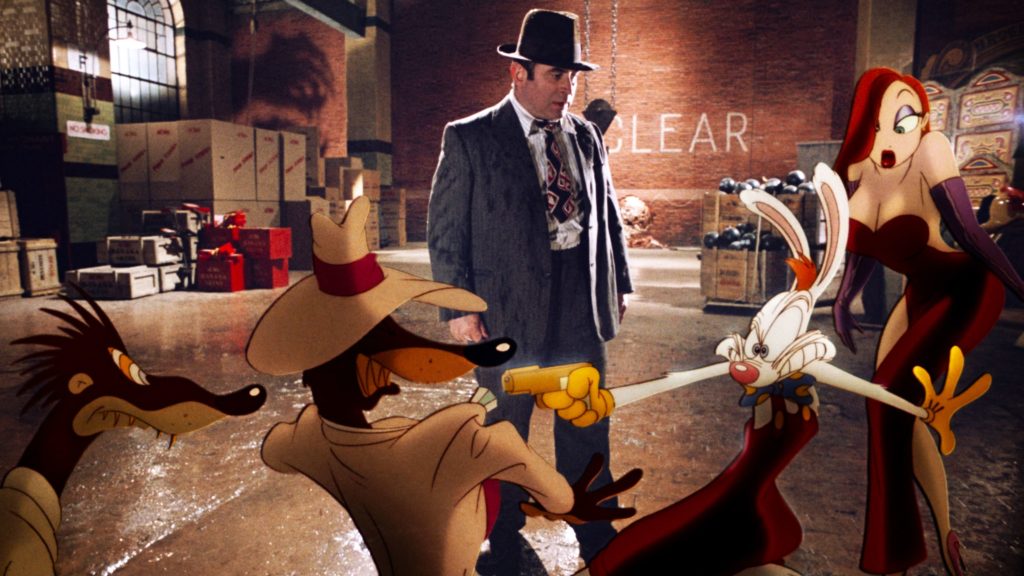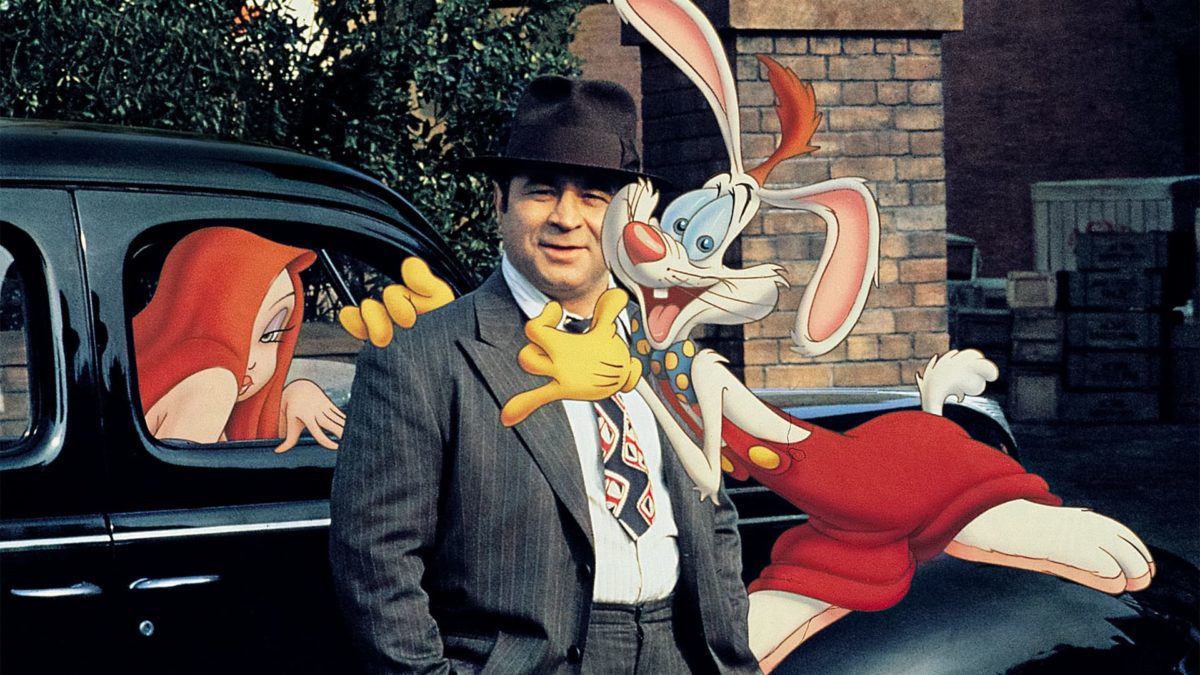I'm not bad, I'm just drawn that way
Normally when a film is cutting edge in visual effects, it looks like crap five years later, let alone thirty-five. Yet Who Framed Roger Rabbit, one of Robert Zemeckis’s biggest triumphs, still looks mind-meltingly cool. Cartoon characters exist in the human world, and vice versa, as the (literal) edge between animation and live action blurs: Eddie Valiant (Bob Hoskins), a human detective, carries around a cartoon gun and shares set pieces with the fully animated Roger Rabit (Charles Fleischer). And it all crests in amazingly satisfying revelation sequence of “Toon Town” — a setting so anarchic and vibrant specifically because it exists opposite the dingy live-action Hollywood where the rest of the story takes place.
The story is a hardboiled detective noir in the classic Raymond Chandler sense: A troubled detective who floats halfway between cop and criminal trying to parse out an increasingly hairy story of murder, sex, and corruption. It’s instinctive to call it a “parody” or “pastiche” of a noir story, but it’s basically a straightforward example of the genre that just happens to include both humans and cartoons — or “toons” as they’re called — with a few jokes to keep it rated PG instead of PG-13.
I think that’s what I love about the movie so much. It doesn’t pull its punches in dumbing down the noir story, charging it with violence and danger and energy. It has the noir tropes, but it somehow all feels fresh and delightful when two thirds of the characters are toons.

One of the clever twists of the screenplay by Jeffrey Price and Peter S. Seaman is to frame the relationship between humans and toons as, essentially, a racial culture clash. Without being too on-the-nose about it, the movie uses the language and dynamics of racism as shorthand for how the toons fit into the human world. This adds a layer of poignancy to the scheme to take over Toontown, and also adds some real edge to Valiant’s anti-Toon but heart-of-gold private eye.
So many of the images in this movie are iconic: There’s Roger Rabbit, a truly chaotic knockoff Looney Tune. The crooked cops as literal weasels is a treat. Jessica Rabbit (Kathleen Turner) is so much fun as the steamy over-the-top femme fatale, her sexuality taking on a heightened degree by being animated. “I’m not bad, I’m just drawn that way.” Judge Doom (Chrostpher Lloyd) is a terrific villain, more frightening than just about any other character in any family-targeted movie I’ve ever seen, a physical embodiment of the toon-human tension. But even beyond the individual characters and settings, what’s most exciting is the constant rush of innovative touches and visual flourishes, like an avalanche of energy.
For this movie to work, the lead needs to anchor the film. Sure enough, Hoskins is absolutely terrific as a gumshoe, playing the role completely straight for 90% of the runtime and imbuing Valiant with noble tragedy. He really carries the character like he could have appeared in a ’40s film noir, which is supposedly why he beat out so many famous names. (Harrison Ford was almost cast, which is a tantalizing what-if; most of the other floated names, like Chevy Chase and Eddie Murphy, would have been catastrophic.) Zemeckis makes sure the danger of the plot is almost always front-and-center, not just an asterisk to the technical innovation.

Another fun factor is the much-ballyhooed crossovers. The big marketing gimmick: Disney characters and Looney Tunes characters (plus some from a few other studios) appearing onscreen in the same film, often the same frame. It both feels slightly less novel than ever before thanks to the increased use of multi-franchise crossover content in recent years (e.g. Space Jam: A New Legacy, Chip ‘n Dale: Rescue Rangers, and the entire MCU), and also completely refreshing in how unpolished and irreverent it is. Donald Duck and Daffy Duck trying to literally kill each other in a speakeasy piano duel is borderline avant garde in its abandon of corporate boardroom image safety.
There’s also, I’ll add, an outstanding animated short that opens the film and perfectly introduces the Who Framed Roger Rabbit cinematic world. The short is so good it makes me wish that Zemeckis had spent a decade making hand-drawn/CGI-hybrid throwback comic shorts rather than mo-cap monstrosities.
Historically, Who Framed Roger Rabbit an important film. It didn’t kick off a golden of era live action-animation hybrids the way that Jeffrey Katzenberg predicted. But it was crucial in getting the ball rolling in Disney’s animation studio once again, serving as a catalyst for the upcoming “Disney Renaissance” that started with The Little Mermaid a year later.
It’s also a crucial film in the arc of Robert Zemeckis. It’s his first exposure to animation, which would become his futile obsession about 15 years later. It’s also the movie that set up what would become the Zemeckis template for much of the rest of his career: a human story built around a novel, bleeding-edge special effect. I’m not sure we get Tom Hanks in historical footage or two Marty McFlys or a backwards-headed Meryl Streep or recreated Twin Towers without Roger Rabbit.

There are a few bugs that keep me just short of declaring it a masterpiece: Roger Rabbit’s mania is a bit exhausting to spend so much of the movie with, for one. More broadly, the movie seems to err on the side “gee whiz” effect rather than coherent cinematic logic a few times. I don’t quite understand why the climax includes Valiant mutilating himself like a toon when the entire point of his backstory is that toon chaos has had violent repercussions in his life. (Though Hoskins still sells the moment; it’s a fun gag.)
But they are, all up, extremely minor issues. I love this movie. It remains as thrilling and daring and completely satisfying 35 years later as it was the time of its debut.
- Review Series: Robert Zemeckis
Is It Good?
Exceptionally Good (7/8)
Awards, Honors, & Rankings
Dan is the founder and head critic of The Goods. Follow Dan on Letterboxd. Join the Discord for updates and discussion.

